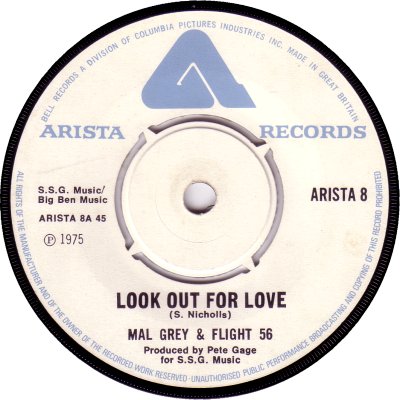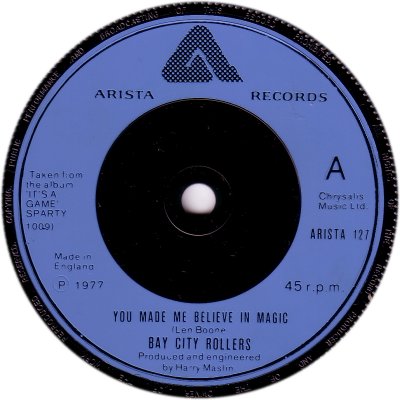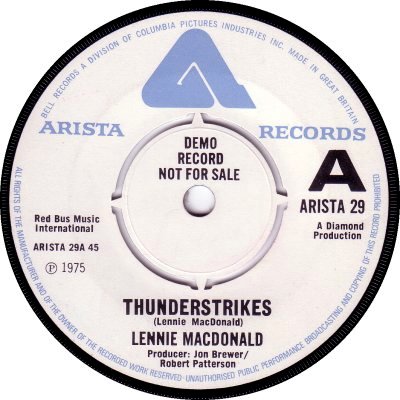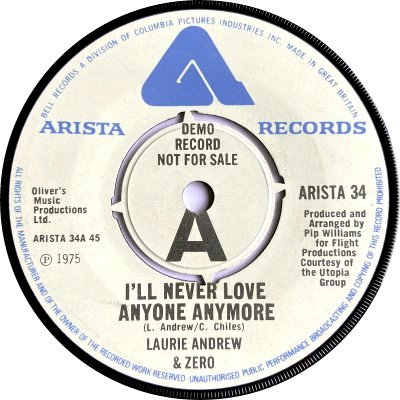







American in origin. Arista received its first mention in the UK trade press when 'Music Week' of the 7th of December 1974 said that it was being launched in the USA and described it as a joint venture between Columbia Pictures Industries and Clive Davis, previously president of Columbia Records. According to 'Billboard' of the 12th of October 1974 CPI's Bell label (q.v.) had performed well overseas but had had 'a disastrous year' in the States, and Davis had been recruited to get things back on course. Davis gave the artist roster a thorough shake-up, dropping many of the old acts and signing new ones. In doing so he changed CPI's emphasis from Pop towards more serious music such as Progressive Rock and Jazz ('BB', 23rd November 1974). The new direction deserved a new label, and it got one. Bell was dropped, in the USA, and was replaced by Arista, which made its debut in January 1975.
Not long after it appeared in America, Arista was launched here. 'MW' of the 18th of January reported that the first releases were scheduled to come out 'next month'; and, in due course, the issue of the 1st of February carried an advert announcing the forthcoming arrival of the new label. As was the case with Bell, it was to be handled by EMI. Singles were numbered in an ARISTA-0 series, and the first of them, Barry Manilow's 'Mandy' b/w 'Something's Comin' Up' (ARISTA-1; 2/75) got the company off to a strong start when it only just failed to crack the Top 10. For a time the Bell and Arista labels appeared side by side in Britain; according to Billboard of the 14th December 1974 Bell had a strong label identity in this country and it was to continue mainly as an outlet for the British artists who had helped establish that identity. A certain amount of pruning of the roster had taken place, however, and new signings were to be offered the choice of which label they wished to appear on. After 'Mandy' other Chart successes proved rather elusive, with only Linda Lewis and Eric Carmen getting into the Top 20, once each, in the first eleven months of 1976 - the more adult-orientated material favoured by Arista was less suited to the Charts than was the comparatively lightweight product of its sister-label Bell. As it happened, the number of hits was to increase in 1977. 'MW' of the 18th of September 1976 broke the news that the Bell label was to be phased out and that its artists were to be transferred to Arista. A company spokesman was quoted as saying that new signings almost always preferred to be on Arista anyway. Ex-Bell artists such as The Drifters, Gary Glitter and the Bay City Rollers scored for their new label in 1976-77, but the biggest contributors were Showaddywaddy, with a run of six Top 5 singles during 1977-78.
In the summer of 1977 Arista formed a joint sales force with Chrysalis (q.v.). Both companies left EMI and moved to Phonogram / Phonodisc on a manufacturing and distribution deal. According to 'MW' of the 25th of June it was the first time that Phonogram had agreed a deal of that kind. The article added that the new sales force, 'Tandem Record Sales', was to be based at Phonodisc's headquarters in Chadwell Heath. Arista continued to enjoy Chart hits, with the likes of George Benson, Raydio and the Patti Smith Group; Showaddywaddy continued their run, and Barry Manilow found a new lease of life from 1978 onwards. Its catalogue offered records by a wide variety of acts, ranging from Dionne Warwick to Iggy Pop by way of The Kinks. In addition a couple of small independent labels, Acrobat and Zoom, came on board (q.v. both). The deal with Phonodisc was extended in February 1979 ('MW', 24th). Big changes were coming, however. 'MW' of the 4th of August 1979 reported that, subject to approval by the boards and banks involved, German company Ariola Eurodisc intended to buy out Arista, for an initial investment of fifty million dollars. Approval must have been forthcoming, as 'MW' of the 13th of October was able to state that the purchase had been completed. Restructuring took place, and 'MW' of the 1st of March 1980 said that Arista and its new sister Ariola had been reduced to A&R, production and label companies, with two other firms taking over responsibility for marketing and finance. All of these concerns headed on into the '80s, and out of the range of this site, as parts of the newly-formed New Bertelsmann Record Company.
One label design served Arista throughout the '70s, though there were variations. During the time when EMI was responsible for manufacture and distribution paper labels were used: they started off as white (1), and turned black (2) at the beginning of 1977. After the move to Phonodisc injection moulded labels became the norm (3). The occasional paper label continued to appear (4, 5), presumably as a result of contract pressings - pressings made by a different company owing to pressure of demand. The second example shown is a CBS pressing, and I have a Pye pressing of that same record. EMI-era demo copies were marked in the usual EMI manner, with the appropriate text and a medium-sized 'A'. Until November 1975 the 'A' was at the right-hand side (6) but from then on it migrated to the centre (7, 8). There were no demo markings during the Phonodisc years, and there was no company sleeve until the 1980s. As stated above, catalogue numbers were in the ARISTA-0s to begin with; the prefix was shortened to ARIST in at the start of 1978, but the numbering stayed in step. The discography below only covers the 1970s. Thanks to Robert Bowes for the fifth scan and to John Timmis for the seventh.




Copyright 2006 Robert Lyons.

